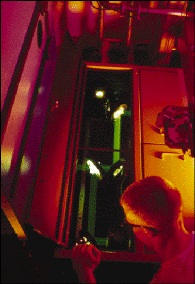Barbara Grant
LIVERMORE, Calif. -- Nuclear energy provides about 20 percent of the electricity used in the US, but separating uranium isotopes for power generation has been a power-hungry task itself -- until lasers offered a new method.
To fuel nuclear reactors, enriched uranium containing between 3 percent and 5 percent of the U-235 isotope must be extracted from uranium oxide that contains natural levels of 0.7 percent U-235. The traditional extraction techniques, gaseous diffusion and gas centrifuge, are inefficient, costly and uranium-hungry.

Lasers offer an efficient alternative to the painstaking process of uranium enrichment. Courtesy of the Lawrence Livermore National Laboratory.
|
A newer technique, called atomic vapor laser isotope separation, is more efficient and cheaper, and so the Maryland-based US Enrichment Corp., a government corporation in the process of privatizing, is funding a large effort to improve the technique and the technology.
Bruce Warner, process engineering manager at the Lawrence Livermore National Laboratory, explained the laser-enrichment process that the lab developed: The separation system creates uranium vapor. Engineers aim a dye laser beam tuned between 550 and 650 nm at the vapor stream to ionize the U-235 atoms, which an ion extractor can then collect. The remaining U-238 vapor passes through the extractor for collection on a separate structure.
Because dye lasers are efficiently energized by other light sources, a second system formed by multiple copper laser chains provides the power at wavelength outputs of 511 and 578 nm. Each copper laser chain includes an oscillator, an optical relay telescope and three amplifiers.
Process to production
For production-scale separation, engineers will expand the copper and dye laser chains and add separator systems and industrial computer control systems. Each system will require about 42,000 optical elements ranging from 1 to 8 in. in diameter, half of which will be custom-built.
According to US Enrichment Corp. spokesman Joe Tomkowicz, a laser-based uranium production facility would consume only 5 percent of the power required by gaseous diffusion plants, require less capital investment than a new centrifuge plant, and use 20 to 30 percent less natural uranium than those technologies required to produce a similar amount of U-235.
Warner said he expects construction of a laser-based separation facility to begin in 2001, pending US Enrichment Corp.'s sale to the private sector and Nuclear Regulatory Commission license approval. Full production should be achieved in 2005, when the plant will use hundreds of kilowatts of copper laser pump power to produce many tens of kilowatts of dye laser power output.
